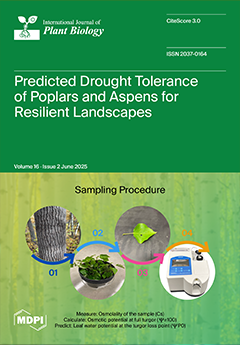Among the numerous diseases that affect papaya (
Carica papaya L.) cultivation, anthracnose, caused by a complex of fungi from the genus
Colletotrichum spp., stands out, primarily due to its damage to the commercial part of the papaya, the fruit, specifically the pulp. Although
[...] Read more.
Among the numerous diseases that affect papaya (
Carica papaya L.) cultivation, anthracnose, caused by a complex of fungi from the genus
Colletotrichum spp., stands out, primarily due to its damage to the commercial part of the papaya, the fruit, specifically the pulp. Although chemical control with synthetic molecules is the most commonly used method to combat anthracnose, it is not the most appropriate solution. The indiscriminate use of synthetic chemical products results in numerous harmful effects on the environment, the health of farmers, and the final consumers. Given these circumstances, the objective of this study was to analyze the efficacy of essential oils (EOs) from
Citrus aurantium var.
dulcis L., known as sweet orange,
Citrus limon (L.), known as Sicilian lemon, and the major compound present in these oils, limonene, against the pathogens
Colletotrichum okinawense, which cause anthracnose in papaya fruits. The percentage inhibition of mycelial growth was evaluated on the seventh day, with estimates of 50% and 90% inhibition, to compare the inhibitory effect among the fungal isolates. Chromatographic analysis revealed that sweet orange EO contains myrcene and limonene. Sicilian lemon essential oil includes myrcene, limonene, α- and β-pinene, and γ-terpinene. Both EOs and limonene exhibited activity against
C. okinawense. The 50 µL/mL concentration was the most effective in inhibiting growth. The EOs and limonene showed similar IC
50 values, with limonene at 48 µL/mL, Sicilian lemon EO at 51 µL/mL, and sweet orange EO at 57 µL/mL.
Full article




